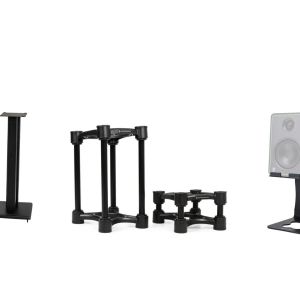It’s not too much of an exaggeration to say there are two kinds of Genesis fans. There are the ones who strongly prefer the music the group made when Peter Gabriel fronted the band. And there are those who favor the later albums recorded with Phil Collins at the mic.
Videos by American Songwriter
It wasn’t just Gabriel’s performances that the fans of early-era Genesis missed with their post-1975 work. Genesis became better known for shorter, more pop-oriented songs, especially once lead guitarist Steve Hackett left the band in 1977. Increasingly, three- and four-minute songs were popping up on their albums, while 10-plus minute opuses were becoming rarer.
Who Says the 80’s Didn’t Have Prog?
Still, every one of Genesis’ seven post-Hackett albums (six of which featured Collins as their lead singer) had at least one track exceeding seven minutes. At least that’s true if we count the 11 continuous minutes of “Home by the Sea”/”Second Home by the Sea” from their 1983 self-titled album as one track.
Many rightfully point to the 23-minute long “Supper’s Ready” from the 1972 album Foxtrot as the epitome of Genesis’ early musical approach. It was actually the only time they released a track that was nearly the entire length of an album side.
No doubt some fans can’t imagine ‘80s Genesis filling 15 minutes of an album with a single track. So it will shock those fans to learn they nearly did it twice during that decade. During the era they were burning up the charts with “Invisible Touch,” “That’s All,” and “Misunderstanding,” Genesis recorded two massive suites. One was for their 1980 album Duke. The other appeared on the 1981 release Abacab.
If you’ve heard either of these albums, then you already know all or most of these suites. The band would ultimately chop them up into shorter songs. Here are the stories behind these two monumental Genesis suites. They could have changed the way we look at the band’s trajectory.
“The Story of Albert” from Duke
This mini-rock opera, sometimes referred to as the “Duke Suite,” is actually on Duke in its entirety. But instead of having it take up 28-plus minutes of one side, Genesis split it up into three parts. The album begins with the first three songs in the suite–”Behind the Lines,” “Duchess,” and “Guide Vocal.” These three tracks detail Albert’s romantic pursuit of the Duchess, her rise and fall as a popular singer, and their eventual split.
The rest of the suite is on Side 2, with “Turn It On Again” opening up the second half of the album. The song takes us through Albert’s obsession with the TV programs he watches, thinking that the characters on the shows are his friends.
Yes, a Popular Prog Radio Single!
As a stand-alone single, it received frequent airplay on album-oriented rock stations. It also had some minor crossover success, reaching No. 58 on the Billboard Hot 100. Then the album ends with “Duke’s Travels,” which is mostly instrumental but also reprises the lyrics from “Guide Vocal,” and “Duke’s End,” which reprises the instrumental intro from “Behind the Lines.”
Splitting up the suite may have prevented detractors from accusing Genesis of reinventing the wheel they first created with “Supper’s Ready.” But it still manages to replicate some of the older song’s best qualities. The suite’s components evoke a variety of moods. And the “Duke’s Travels”/”Duke’s End” finale gives the album a satisfying, spine-tingling conclusion.
Though they broke the suite up into smaller pieces on Duke, Genesis did perform it as one continuous piece on their Duke tour. Phil Collins would walk fans through the story before the band would embark on the extended piece.
The “Dodo Suite” from Abacab
Side 2 of Abacab opens with a mini-suite of “Dodo” and “Lurker.” Genesis keyboardist Tony Banks has said the band had considered turning it into a longer composition. It would have incorporated two instrumentals, “Naminanu” and “Submarine.” Those latter two tracks did not appear on Abacab, but “Naminanu” was released as the B-side to “No Reply at All” (in Europe) and “Keep It Dark” (in the U.K.), while “Submarine” was on the B-side of the “Man on the Corner” single.
Thematically, the inclusion of “Submarine” as part of an extended suite makes sense, given that “Dodo” has several allusions to “the ocean” and “the sea.” Also, “Lurker”’s fadeout segues nicely into “Submarine”’s spare intro, which consists of Collins quietly drumming over a soft Banks keyboard pad.
No one in Genesis has specified how the four pieces of the suite would have been arranged, sparking debate among fans on message boards. Two theories have gained some traction, with one set of fans thinking the expanded suite begins with the version of “Dodo/Lurker” that appears on Abacab, followed by “Submarine” and “Naminanu.” Another faction thinks “Naminanu” was intended to kick off the suite, as its sudden ending transitions well into “Dodo”’s jarring intro. The suite continues with “Lurker” and then with “Submarine” as its finale.
A Half-Full-Throated Statement
We may never know how the suite was intended to progress or if Banks, Collins and Mike Rutherford ever got that far in developing it as a four-song entity. At least one fan has made a convincing case for the “Naminanu”/”Dodo”/”Lurker”/”Submarine” configuration, having constructed the suite in that order—smooth segues and all—for a YouTube video.
Years before the calendar flipped from 1979 to 1980, long rock tracks with extensive instrumentals had fallen out of fashion. Even without these two suites, Genesis does not get sufficient credit for bucking the trend with the longer songs they did include on their ‘80s albums. Still, they would have made quite the statement by keeping both suites intact.
Photo by Michael Ochs Archives/Getty Images
